Obliteration Excavations 1: 'Para' to 'Para'
In 1999, I was a poetry fellow at the Fine Arts Work Center in Provincetown. Then, I had only recently finished the first set of comprehensive examinations of my doctoral program at the CUNY Graduate Center, which was, for me, no easy feat. I have never been a naturally great test taker, and the obstacle of mastering specific field knowledge of the English canon, demonstrating proficiency in English prosody, and revealing dexterity in the deployment of discrete theoretical frameworks, and having to present these in timed intervals, handwritten in Blue Books, was a difficult challenge. Between failure, and success. Lots of Granola. Lots of Post-its, and charts on graph paper, I drew one body of reading to the next, dividing and building a way of seeing that was at some remove, then, from the world I attempted to construct through the work of poetry.
Certain texts saved me, Shakespeare’s The Tempest, Toni Morrison’s Beloved, Gary Fisher’s Gary in Your Pocket, Harriet Beecher Stowe’s Uncle Tom’s Cabin, and so too, professors, Meena Alexander, Wayne Koestenbaum, Michele Wallace, Eve Sedgwick, Anne Humpherys, Joan Richardson, the list in a way, is indirect, and not exhaustive, but so is the direction through which I would navigate questions of race, sexuality, and loss in my writing and being, in such a way that I could learn to organize my own readings of various works into largely sequential and linear narratives through the space of violation and radical (psychic, embodied, lived) fragmentation.
Some parts of the examinations, I sailed through, deciding to write about Sapphire’s Push, centering on her main character, Precious, and the role of epithet, race and the abject through Julia Kristeva—I think it was, the Powers of Horror that helped me most, but when it came to figuring out where certain lineages moved or intersected outside of the contemporary, I had to figure out how to scaffold in works by John Donne, and William Blake, too, to trust in my ear and eye to argue how specific histories and periods housed their works, a hard but expansive frame that helped me to learn to listen closely enough to hear the language I feel now when I return to them, a language to help me say what I wanted to say in that space of the protracted examination.
When I finished the tests, I leaped at the opportunity to leave for a year, where I was, in a sense running not away from the PhD, but towards a silence that, at that time, I did not realize I needed, a silence in which I could begin to deeply contend with the primary subject of my work, which was then, and to a large extent, continues to be now, the enduring question of the violated black body, the fragmented, split apart body, the enslaved body, the ensnared body, the body on the run, the body having to leave everything it knows behind, a body in fragments, but somehow, a body alas, free and turned on, surrendering to the quiet of the snow as it would pile on the stairs, and up the entire flight to my porch, jetting out behind the rest of the house.
My escape from NY to MA was a radical shift, from one world to another, seven months of one life into a future, to go and write in the quiet and cold, this memory of me, tucked away alone in some early afternoon in a black puffy coat, sitting on a rock on the beach, fighting the wind, staring out at the cold, white surf, into the rocky beach and bay. This, I remember thinking, is everything a poet needs to pay attention to, the wind, the rocks, the snow, the cold, the sweeping waves, the sitting.
And even though, I have left the snow and white of the East to be near another ocean, the Pacific, to work and to teach amidst the Redwoods in Santa Cruz, some fifteen years later I am still engaged with similar questions of how to negotiate the power of violence, its iterations, its clinging to my body, bodies marked, shocked, killed, trapped, and set out for a kind of perusal, again and again, to look; and in my work, these lines from Gwendolyn Brooks’s “Boy Breaking Glass” continue to travel with me:
I shall create! If not a note, a hole,
If not an overture, a desecration.
I was young then. Perhaps I identified with the boy in the poem? Or perhaps it was/is Brooks’s attention to the site and stealth of the speaker’s desire to identify and to quantify the conceptual space of creation, one bound by its inherent implosion, and its concomitant release.
In her Report from Part One, Brooks attempts to mine this field, to articulate working with the figure of desecration, the overture, I would argue, of the obliterated. In the autobiography, Brooks describes, people of [my] “distinctive history,” “bolted to trees,” “sliced or burned or shredded,” “knocked to the back of the line,” “separated, denied, hounded, hooted at, or shunned,” This “litany of verbs,” a turn of phrase I employ in my dissertation, drafts of the following book project, a poem, and a few talks, Brooks’s words continuing to reverberate. In a sense, the verbs operate like a set of moving bridges that allow me to see and to conceptualize a way of understanding how Brooks was able to move from the act of attending to this violation, to capturing its sense, sensation, and feeling, one of being both trapped by, and hoping to reveal the nature of this insistent captivity.
In Provincetown, I was learning from Brooks, and others, to be attentive to the complex configurations of violence—I’m not sure if understanding violence as both reality and metaphor helped to reveal my relationship to the experience of what it meant to address this in my research, my writing, or what, exactly, I hoped to discover through the creation of poems. I just remember drafting. I made a working wall of photographs, of cut outs, of drawings. I was attentive to a stream of violence in materials that I was encountering in accounts of slavery, news on the radio, and in the daily papers. It is now so hard to assemble what I culled, as my drafts are somewhere in files, in a box, on the other side of the country, but still, in me, its archive persists.
What could be seen and mapped?
What was a boy to do so far away from home?
One morning, sometime after I gave my reading at the Work
Center, as a fellow,one of the other fellows called me on our land lines,
and said, he wanted to talk to me about the reading.
I thought he was curious.
I thought he cared about the content, the way I made
peopleall scared, or mad, and some other nights before, some burst
into the night, away.
Some would, again.
There was a knock at my door.
We had tea.
I clarified that I was trying to find a language in my poems that traversed my meditations on violence, sometimes from headlines like “Cops say 81-year-old Ruby Jean Johnson was raped and then slain by a crack addict last year in her Harlem Apartment,” the flash of light in her glasses in the photograph in the Daily News, cutting across some recent material I was reading on Roland Barthes’ in his Pleasure of the Text. I recall trying to describe how a poem might contain, interpret such events, outside of language.
He was not listening. I wanted him to go away, but I also wanted to address him, or the spectacle that stood in front of us, with a clarity that was slipping away from me as I decompressed between the pressure of the poems I shared, those to be written, and the language I wanted to find to explain why this gratuitous violence—his words—was necessary in my writing. I took my teacup back. I kicked him out of my house when he stopped me, saying I shouldn’t write of such things.
In Santa Cruz, the physician that removes the remainders of the splinter from my foot asks me what I write about as she carves open just at the surface of the ball of my foot. She knows what I know, that she is cutting only into the callous, and it does not hurt, but I say it does. I say it does, because I see her scalpel, and as she prods, she sees nothing, and I do not want another cut in my foot, or a searing shot to dull the pain. I know what she knows, that the splinter is gone, and that once it “spit” itself out of my foot, that was it. The physician explains that she can see “the path of the callous,” when I ask her how she, too, knows that the splinter was once in way deep. She shows how it went straight in, then turned inward, and demonstrates this movement through the arc of her body, her hands held together, a steeple’s tip.
“What kind of poetry do you write?” After she enacts the path of the splinter, I explicate beyond my initial answer, Life, revealing to her that this is what I write about, how to capture the record of violation, absent, but still marked, its painful trace still left behind, the path of the wound that is still there, even though the culprit is gone. There is no time to explicate there, but I know what I want to return to, the archive outside of the archive, the world outside of the facts of knowing, and of seeing. I want to say that “the space of violation is ‘osmotic,’” a phrase I arrive at in a graduate school paper on Marky Mark I wrote in 1998.
Here are two points in the scaffold of my argument:
One, I present Elizabeth Grosz’s notion of the osmotic:
The body image is as much a function of the subject’s psychology and socio historical context as of anatomy. The limits or borders of the body are not fixed by nature or contained by the anatomical “container,” the skin. The body image is extremely fluid and dynamic; its borders, edges, and contours are “osmotic” – they have the remarkable power of incorporating and expelling outside and inside in an ongoing interchange.
Second, I set this into the context of my paper, one that was interested in Mark Wahlberg’s performance as black homeboy monster, violater, (nigger-and-gook-ass kicking) rapper turned wilin’ out enraged, deranged nightmare stalker (Fear) then big dicked porn star (Boogie Nights) rewiring through Fanon, Mercer, and more Grosz, the space of Wahlberg’s volatile body, all bound and framed under the sign of the floating [expletive]:
And here is a central sentence that captures my thinking, then:
Mark’s body, as a fluid, osmotic performance, both acquires and represents, while making hypersexuality within a framework of colonial interchange between various sexual, material and racial discourses. Whether as white negro or in traditional homeboy gesture, his body relies on a history of representation to inform or charge its volatility.
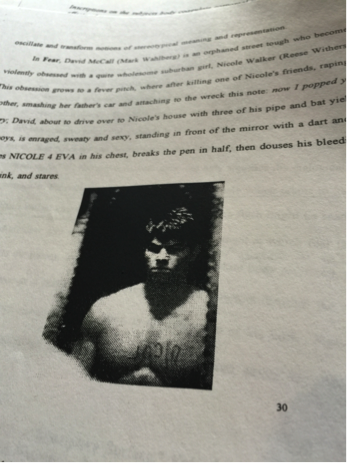
How does violence travel? How does the violation of the filmic travel through the fictive into the real? What activates the space of memory that prompts one to explore the site of violation, those who are killed, those who are raped, a place where even Daddy’s car is smashed, a note left behind by David McCall, played by the actor, Wahlberg:
Now I popped your cherry.
The tricky thing here, in my estimation, is how to mark the ways that violence, and violation is insidiously mobile, not in the sense of its spread, that the dangers of it are marked by its presence. Something else is at stake here. It has to do with not only the resilience of the black body’s abjection, but its appropriation through fantasy, spectacle, and inscription. Here, I borrow again from Grosz:
Inscriptions on the subject’s body coagulate corporeal signifiers into signs, producing all the effects of meaning, representation, depth, within or subtending our social order. The intensity and flux of the sensations traversing the body become fixed into consumable, gratifiable needs and desires.
It is NOW Mark’s desire to be freed from the space of the act, of shouting, “kill the niggers,” and divorced from “chasing three black Dorcester children walking home from Savin Hill.”
It is NOW him wanting to have the record expunged, so that it has never happened, so that he can volunteer to put out fires, or go police:
“We don’t like black niggers in the area, so get the fuck from the area.”
How to define obliteration, the erasure from memory, the act of saying it, and going on the attack? What enrages also propels. We do not want you here, or we want to erase you, obliterate you, and we want to be there when you are gone, winning, “para” to “para” “slant-eyed-gook-mother fucker” is also what he said, and he beat that Vietnamese man with a stick. This is what he did. There is no return. I wasn’t, then, attempting to record this act of violence as a matter or record, and in a sense, maybe I am not doing this even now, but I am pointing, rather, to the ways that the field of violence is mobile, and helps to reveal, specifically, Wahlberg’s ability to travel from role to role, master jewel thief, gambler, rock star, hero, body builder, dad, brother, whatever, wherever in the world it wants him to be, whomever he hopes to become, but the bright white star is forever latched to the heart of the ugly, trail of his lasting actions, his black drag, wanton and left behind, sheening, sparking darkly behind his star power.
Maybe this was and is the onus of his visibility, then, and I was trying to figure out how to write about, “the point of sale which seems to keep Mark’s body in constant violation,” a way of knowing, and a way to be known, a way of seeing him, and a way of understanding, at least in my own archive, what was driving my need to draw the space between the transfer point of this violation from then to then, now to this point, in how recognition of his very presence is dependent upon other violated bodies—gooks, niggers in the star trail—burnt in the wake of Wahlberg’s continuing to blow the fuck up.
Some examples after some definitions:
In a stroke, the March snowstorm obliterated our hopes for an early spring. (Miriam-Webster)
-or-
the obliteration of vast green spaces. (New Oxford American)
This long summer, after just getting off of a Red Eye from CA to NY, I emerge to see Kara Walker’s exhibit, “A Subtlety,” and I can feel the stretch of the rest of the summer in front of me, and all I want to do is to be thin in NY, and I buy a caramel belt, Downtown, to match my wingtips, because I left mine at home, and Dallas and I wait in the hot ass line, thick in Williamsburg, and I record. I make a paper hat out of the standard agreement that says, in fact, that we will be filmed and photographed if we enter, and everyone seems to fill and sign, and once inside, it is okay to take pictures; in fact, it is encouraged.
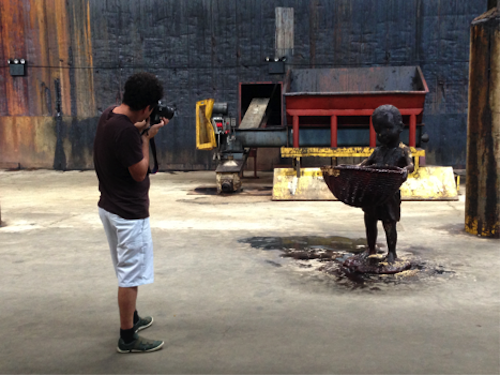
From one mode of consumption into another, the referent in the image, the pool of black waste, source text, one archive flows into the next—This is the view from inside one of the Sugar Baby’s baskets. I loved these little brown babies, boys, too, breaking glass, boys made of powdery, bubbled, fired molasses in brick, sometimes translucent skin, golden powdery sweet flecks in the afros, how could I not I fall in love?
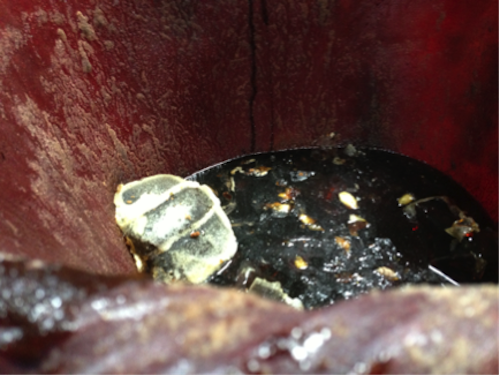
Some still standing, cute cherubic black boys grounding the landscape of Walker’s imaginary, but left to melt in the heat, oh how I also love ALL the space she is taking, the expanse of her imagination filling up an entire factory!
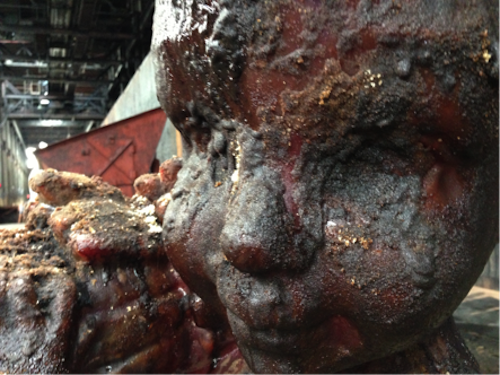
In a sense, I am thinking about reclamation, one act, the act of seeing the figure in the figure, body in the body of the boy I am reading, breaking—little Sugar Baby, so posed and present, yet decreating before our very eyes. Is seeing him remembering him? Is this where I want to return?
Is this the logic that I am attempting to follow?
Decreation:
Desecration.
After Homi Bhabha, I am reminded here of the modes of stereotype, not as in its effects, that is, what we are left with, but rather with what is animated, activated, in the process that stereotype’s signification demands, that is, as he writes in his The Locations of Culture: “The process by which the metaphoric “masking” is inscribed on a lack which must then be concealed gives the stereotype both its fixity and its phantasmic quality—the same old stories of the Negro’s animality, the Coolie’s inscrutability or the stupidity of the Irish must be told (compulsively) again and afresh, and are differently gratifying and terrifying each time.”
Walker’s work enact a process that fills in the space where I am digging through this old paper, caught in the new realization of Wahlberg’s urge for freedom, to be absented from his past, but a past so entrenched with a violent history, that is burns, no matter what he does, no matter what he says, no matter what he wants.
What is it that he doesn’t want
any longer to exist?
What melts before our eyes, continues to stink.
We obliterate.
We are dying.
I am taking pictures.
Dallas, at the museum, talks to one of the guards who lets us in on a secret, that late at night, when it is quiet, and I imagine her alone, Kara Walker returns to the factory to pick up pieces of the fallen, Sugar-Baby-limbs, melted off the (steel) bones and puts them back into the babies’ baskets! Perhaps this is the space of the ingested overture, the note and hole subsumed, desecration in the desire—to want to look inside, and so I did. I do. I wanted to see what smelled so sickeningly sweet. So I did. I wanted to see how to move from the fixed to the phantasmic, and to think of a way to return to the site of violation by looking into the fluid and the osmotic, and not to the thing, dying:
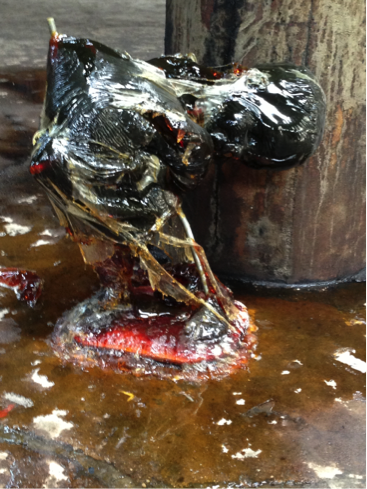
Someone comments on the shootings. Which one?
Now.It has everything to do with you, even if it is over something
else,shooting at the point of definition.
They get jacked.
Rick Lovett, a top commenter writes:
David Anthony Neal ....nice try David, how many innocents were slaughtered due to Mapplethorpes "Piss Christ"....it created a lot of outrage, but NOBODY was butchered, and it was shown all around the world.
But someone else is knocking at the door, and the door is shaking, and I recall seeing the urgency rapt behind a peep-hole, a rattle, to want to break in,
the site of attempting to reach back into something, a return?
David McCall is there.
What is the logic, and where to think of the site of my return
to the link
between what is repeated, and what is seen in an abyss,
the abysmal,
the site of terror?
This is what or where I was, and am getting at in the thinking here through the space between work and what and who is inscribed within the field between what is rank and spreads.
Not like snow. It stinks, and I grow nauseous, and need to
sit.Am I seeking a field of silence, still?
Poet Ronaldo Wilson earned an BA at the University of California-Berkeley, an MA at New York University...
Read Full Biography

